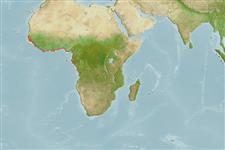>
Syngnathiformes (Pipefishes and seahorses) >
Syngnathidae (Pipefishes and seahorses) > Nerophinae
Etymology: Microphis: Greek, mikros = small + greek, ophis = serpent (Ref. 45335).
More on author: Kaup.
Environment: milieu / climate zone / depth range / distribution range
Ecologie
marien; zoet water; brak water demersaal; pH range: 7.5 - 8.2; dH range: 20 - 30. Tropical; 22°C - 26°C (Ref. 12468)
Africa: west coast of Africa, from Senegal to Angola (Ref. 81680).
Grootte / Gewicht / Leeftijd
Maturity: Lm ? range ? - ? cm
Max length : 20.0 cm SL mannelijk / geslacht onbekend; (Ref. 4509)
Korte beschrijving
Morfologie | Morfometrie
Dorsale stekels (totaal): 0; Dorsale zachte stralen (totaal): 38-54; Anale stekels 0; Anale zachte stralen: 2 - 3. Diagnosis: 41-44 bony rings (mode 43) (Ref. 81680), 19-21 (mode 20) trunk rings (before anus)(Ref. 57226, 81680) and 20-26 tail rings (behind anus)(Ref. 81680). 8.0-9.75 total subdorsal rings, 1.75-3.5, usually 2.5 or more, subdorsal trunk rings and 5.25-7.0, usually 5.75-6.5, subdorsal tail rings (Ref. 81680). Head length 4.8-5.6 (mean 5.2) times in SL (Ref. 57226, 81680). Snout 1.5-1.7 (mean 1.6) times in HL (Ref. 81680).
Coloration: general colour of preserved specimens dark brown, but pattern often highly variable within a single sample; lateral part of snout with dark brown blotches or stripes; body plain, blotched or with vague pale mid-lateral trunk stripe; dorsum and belly somewhat paler than flanks; ventral part of head light brown; opercle with numerous small dark brown spots and often a narrow horizontal dark, silvery stripe situated towards upper edge; caudal fin mainly brown with pale edging; other fins hyaline or with fin rays edged with brown; no consistent differences in preserved colouration of various subspecies (Ref. 81680).
Occurs in coastal rivers, streams and estuaries (Ref. 4127, 81680). Found in sea grasses and above sandy substrates in shallow water near shore a.o. (Ref. 81680). Ovoviviparous (Ref. 205). Breeds in fresh water (Ref. 81680). Male carries the eggs in a brood pouch found under the tail (Ref. 205). Eggs develop in the brood pouch for 1-3 weeks, until young of about 1.5 cm TL leave the pouch (Ref. 81680). Maximum reported total length for M. b. aculeatus 17.1 cm (Ref. 81680).
Levenscyclus en paargedrag
Maturiteit | Voortplanting | Paaien | Eieren | Fecunditeit | Larven
Eggs are attached to a kind of brood pouch, formed by two skin folds on the belly of the male (Ref. 13371).
Dawson, C.E., 1986. Syngnathidae. p. 281-287. In J. Daget, J.-P. Gosse and D.F.E. Thys van den Audenaerde (eds.) Check-list of the freshwater fishes of Africa (CLOFFA). ISNB, Brussels; MRAC, Tervuren; and ORSTOM, Paris. Vol. 2. (Ref. 4127)
Status op de Rode Lijst van het IUCN (Ref. 130435)
Gevaar voor de mens
Harmless
Gebruik door de mens
Visserij:
Meer informatie
Leeftijd/GrootteGroeiLengte-gewichtLengte-lengteLengtefrequentiesMorfometrieMorfologieLarvenLarvale populatiedynamiekRekruteringAbundantieBRUVS
ReferentiesAquacultuurAquacultuurprofielKweeklijnenGeneticaElectrophoresesErfelijkheidZiektesVerwerkingNutrientsMassaconversie
Tools
Speciale rapporten
Download XML
Internetbronnen
Estimates based on models
Preferred temperature (Ref.
123201): 25.2 - 28, mean 27.3 °C (based on 171 cells).
Fylogenetische diversiteitsindex (Ref.
82804): PD
50 = 0.5000 [Uniqueness, from 0.5 = low to 2.0 = high].
Bayesian length-weight: a=0.00085 (0.00032 - 0.00224), b=3.04 (2.81 - 3.27), in cm total length, based on LWR estimates for this (Sub)family-body shape (Ref.
93245).
Trofisch niveau (Ref.
69278): 3.4 ±0.4 se; based on size and trophs of closest relatives
Weerstandsvermogen (Ref.
120179): Hoog, minimale populatieverdubbelingstijd minder dan 15 maanden (Preliminary K or Fecundity.).
Fishing Vulnerability (Ref.
59153): Low vulnerability (14 of 100).
